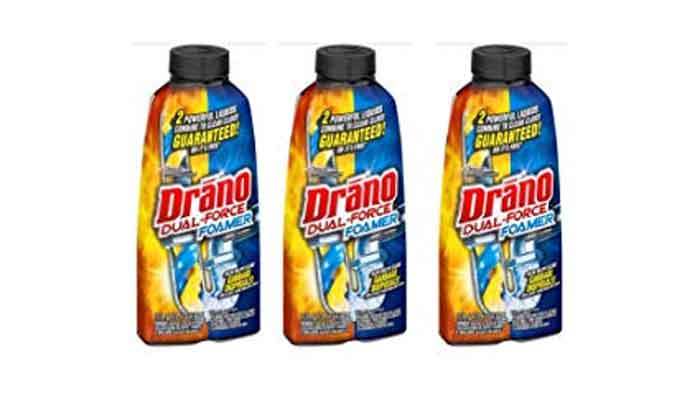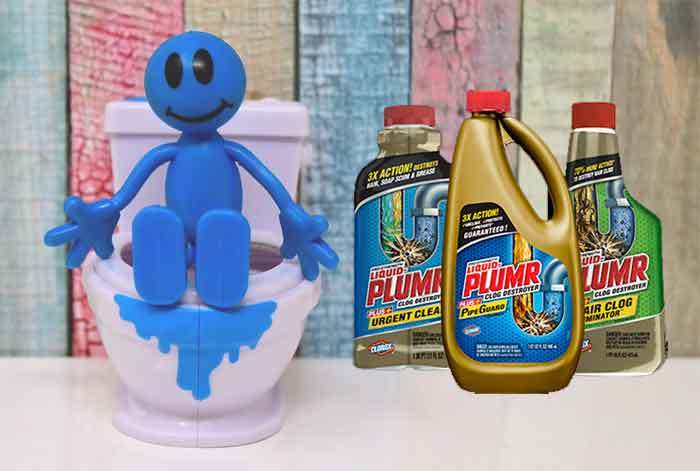Disclaimer: This post may contain affiliate links, meaning we get a small commission if you make a purchase through our links, at no cost to you. For more information, please visit our Disclaimer Page.
One of the most annoying things in the world are clogged drains.
Somehow it always happens out of nowhere, and it leaves your bathroom and kitchen messy and your sink and bathtub dirty. Today we are blessed to have a variety of choices when it comes to choosing a good and fast cleaner.
Using a drain snake, plungers, or other similar products, can take forever and it is usually extremely messy and difficult. Not to mention hygiene problems when removing clogs in toilets.
As soon as I found chemical products that work, I stopped using those instruments.
Thanks to the years of experience, I had the opportunity to test almost every drain cleaner on the market and notice similarities and differences. All of them claim to be the fastest and the most efficient cleaners you’ll ever use, but the reality is that some of them can cause an even bigger mess.
Since drains can clog several times during a year, almost everyone wants to avoid calling a plumber and needs something that will clean the pipes quickly and thoroughly.
In this post, I will discuss and compare two of the most popular and most used products that will effectively clean the pipes in your home and save you the trouble and stress.

I will write about Drano and Liquid-Plumr, compare them and talk about similarities, differences, precaution measures, and every detail you should know about both of these products, in order to help you decide which one would be the best purchase for the clogged drains in your kitchen or bathroom.
Drano vs. Liquid-Plumr – Similarities and Differences
Both products are very affordable and can be found in most stores. In other words, they are easy to find and won’t break the bank.
Not understanding the instructions on products like these can be stressful and risky, especially for common users that don’t have any experience. Both of these products have simple directions that are easy to follow.
Using Drano and Liquid-Plumr is simple – in both cases, you pour the amount of product that is written in the instructions on the bottle, wait for a couple of minutes, let the water run, and observe while everything that’s inside your pipes is slowly melting and your drain is becoming clean and odor-free.
The caps on the bottles of these products are child-proof, which is a very important feature when you have little kids that could try to open the bottles. The child-proof cap is the one that you need to push and turn counterclockwise in order to open it.
Both Drano and Liquid-Plumr have similar substances that will clean your pipes effectively. However, Drano contains sodium silicate, the ingredient that is not found in Liquid-Plumr. Keep this in mind when choosing, since PVC pipes are unlikely to handle this liquid gas.
Finally, Drano has a wider range of products, specially designed for different drain problems, which can be very useful.
Even though Liquid-Plumr doesn’t offer a variety of choice like Drano, it still offers a few options regarding the formula of the cleaner – liquid or foam.
Features of Drano and Liquid-Plumr
Now let’s talk about both products individually, so you can decide which one is the best choice for your household:
Drano
Whether you prefer gel formula or the foamy one, this brand offers a variety of choices not only form wise. You can choose the product for specific situations, so you always know what works best.
You have the solution for kitchen, bathroom and garbage disposal drains, and unclogging them in a matter of minutes is guaranteed.
Some people dislike cleaners that produce foam because they can leave a mess that requires a bit of cleaning up.
If you’re one of them, Drano offers gel products that are thicker than the majority of gel pipe cleaners on the market. This helps a lot with standing water and stubborn clogging.

Drano products contain sodium silicate that is very efficient, but you must be careful because using other chemicals right before Drano because they can react with sodium silicate.
Since it is efficient and strong, using it in the PVC pipes would not be the smartest idea, even though they claim it is safe for all pipes.
PVC pipes, in general, are very risky to treat with chemicals, and it would be safer to use another product such as drain snake or similar instruments. If you dislike using those, like me, search for a better alternative because Drano could damage PVC pipes.
I use Max gel when I need to remove hair clogs and standing water, and Drano granules against grease clogs.
If I need to clean slow drains and get rid of odors, I always prefer using the foamer or liquid. It works well every time and doesn’t leave a lot of mess!
Liquid-Plumr
This is one of the cheapest pipe cleaners on the market, so I always use this one when I’m on a budget or when I need something to unclog the PVC pipes.
The formula of Liquid-Plumr is not as aggressive as the Drano formula, since it doesn’t contain sodium silicate. However, it is still equally effective.
Sometimes I use this product just to clean the pipes even when they are not clogged. It gets rid of the odors and removes any soap, food or hair residue that could provoke clogs later on.
Liquid-Plumr coats the pipes and removes any clog within a few minutes, without compromising the quality of pipes.
However, you should not use Liquid-Plumr in your toilet because it could "eat away" the wax ring. Click here to learn why.

The only thing that can be considered negative is the strong chemical smell this product leaves. However, the smell disappears very quickly so if you’re bothered by it, put a mask over your nose and mouth while using it and it won’t be a problem.
Keep in Mind
Don’t forget to read the instructions before using any of these products, since these contain very serious chemical substances that are hazardous and can harm your health if not used right. If you use too much of both Drano and Liquid-Plumr, you could potentially damage your pipes.
Read carefully how much product to use, for how long to wait and be sure not to use a plunger right after using these products, since there will be a residue in the pipes that can be pulled out and splash your face or eyes.
I always wear gloves and sometimes a mask when using products like these, for added precaution.
As said, be sure not to use other chemical substances right before or after using Drano, since it will probably provoke a chemical reaction because Drano contains a liquid gas (sodium silicate) that reacts with a lot of the similar products and creates foam and vapor that shouldn’t be inhaled.
Final Word: Drano vs. Liquid-Plumr
I can easily recommend both products since both Drano and Liquid-Plumr do the job and clean your pipes, removing any soap residue, hair, grease, food and other things that can clog your drains.
They are much better than a lot of the expensive products on the market, so why would you spend a ton of cash if you don’t have to?
While both of them are excellent, I definitely wouldn’t recommend Drano if you have PVC pipes in your home, because it can damage them with sodium silicate and create bigger damage than before.
With those pipes, it’s better and safer to use something similar to drain snakes, or Liquid-Plumr when you want something fast and efficient.
If you don’t have PVC pipes and prefer thicker gel formula, feel free to use Drano without any risk and get rid of those stubborn clogs in a matter of minutes.
Keep your drains clean, without hair, soap or grease residue. You can use these products once a month if needed, or once every few months and you won’t have to worry about clogged drains ever again.


